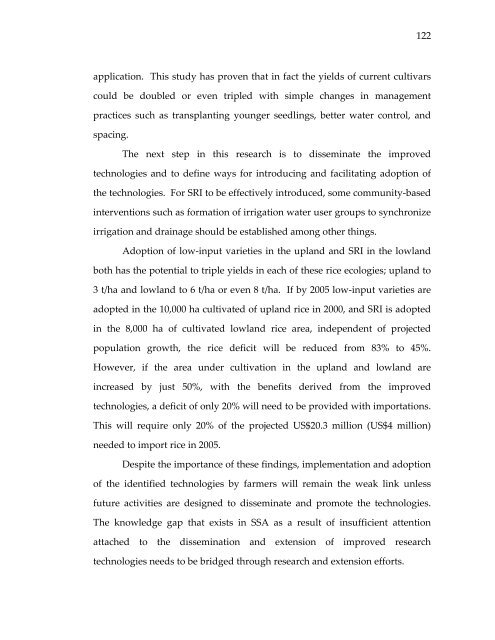Management of rice production systems to increase productivity
Management of rice production systems to increase productivity
Management of rice production systems to increase productivity
You also want an ePaper? Increase the reach of your titles
YUMPU automatically turns print PDFs into web optimized ePapers that Google loves.
application. This study has proven that in fact the yields <strong>of</strong> current cultivars<br />
could be doubled or even tripled with simple changes in management<br />
practices such as transplanting younger seedlings, better water control, and<br />
spacing.<br />
122<br />
The next step in this research is <strong>to</strong> disseminate the improved<br />
technologies and <strong>to</strong> define ways for introducing and facilitating adoption <strong>of</strong><br />
the technologies. For SRI <strong>to</strong> be effectively introduced, some community‐based<br />
interventions such as formation <strong>of</strong> irrigation water user groups <strong>to</strong> synchronize<br />
irrigation and drainage should be established among other things.<br />
Adoption <strong>of</strong> low‐input varieties in the upland and SRI in the lowland<br />
both has the potential <strong>to</strong> triple yields in each <strong>of</strong> these <strong>rice</strong> ecologies; upland <strong>to</strong><br />
3 t/ha and lowland <strong>to</strong> 6 t/ha or even 8 t/ha. If by 2005 low‐input varieties are<br />
adopted in the 10,000 ha cultivated <strong>of</strong> upland <strong>rice</strong> in 2000, and SRI is adopted<br />
in the 8,000 ha <strong>of</strong> cultivated lowland <strong>rice</strong> area, independent <strong>of</strong> projected<br />
population growth, the <strong>rice</strong> deficit will be reduced from 83% <strong>to</strong> 45%.<br />
However, if the area under cultivation in the upland and lowland are<br />
<strong>increase</strong>d by just 50%, with the benefits derived from the improved<br />
technologies, a deficit <strong>of</strong> only 20% will need <strong>to</strong> be provided with importations.<br />
This will require only 20% <strong>of</strong> the projected US$20.3 million (US$4 million)<br />
needed <strong>to</strong> import <strong>rice</strong> in 2005.<br />
Despite the importance <strong>of</strong> these findings, implementation and adoption<br />
<strong>of</strong> the identified technologies by farmers will remain the weak link unless<br />
future activities are designed <strong>to</strong> disseminate and promote the technologies.<br />
The knowledge gap that exists in SSA as a result <strong>of</strong> insufficient attention<br />
attached <strong>to</strong> the dissemination and extension <strong>of</strong> improved research<br />
technologies needs <strong>to</strong> be bridged through research and extension efforts.
















